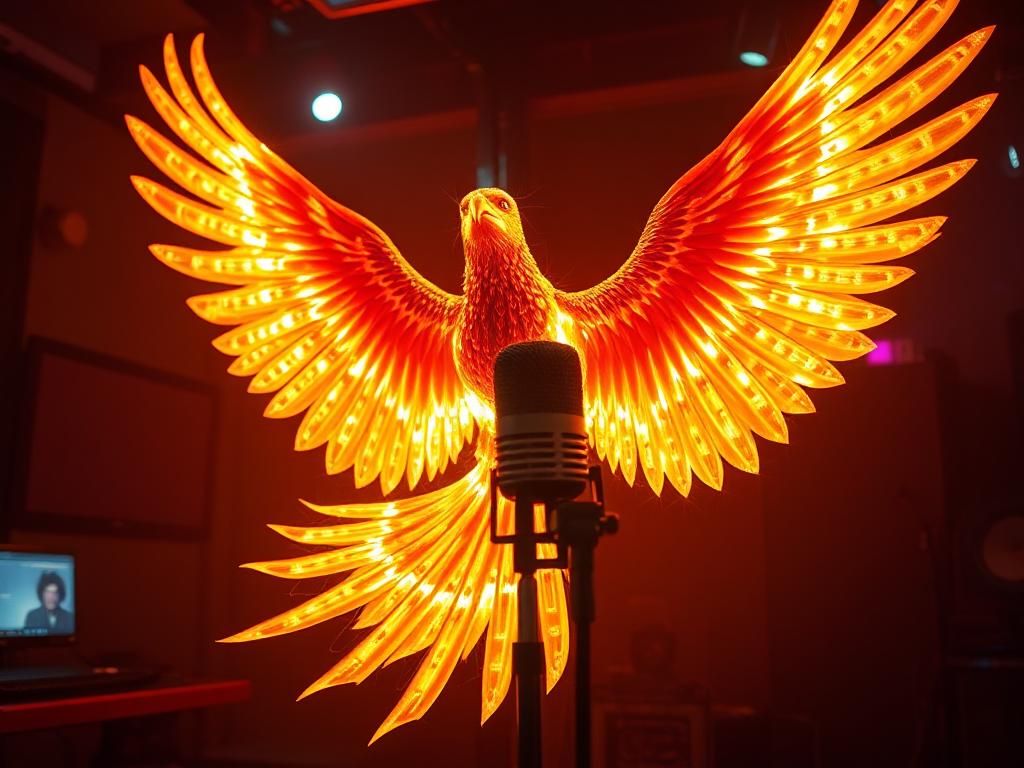THE RESURGENCE OF A HIP-HOP ICON
In an era where technological advancements constantly push the boundaries of human endeavor, the world of music is witnessing a profound transformation. At the forefront of this groundbreaking shift is Beanie Sigel, a revered figure in hip-hop, whose journey has taken an extraordinary turn. After years battling the physical aftermath of a life-altering incident, Sigel has harnessed the power of artificial intelligence to reclaim his signature vocal delivery, signaling a new chapter not just for his career, but potentially for the entire music industry. This audacious move, marked by his recent appearance on D. Jones’ new track “Motion Picture,” is more than just a comeback; it’s a testament to artistic resilience and the innovative spirit that defines modern music.
A JOURNEY OF ADVERSITY: THE SILENCING OF A LEGEND
For fans of raw, unfiltered lyricism and the gritty narrative of East Coast hip-hop, Beanie Sigel, affectionately known as “Beans,” has always been an indispensable voice. Rising to prominence under the Roc-A-Fella Records banner in the 2000s, his distinctive baritone and street-wise storytelling carved out an iconic niche. However, a near-fatal shooting incident in December 2014 dramatically altered his life and, critically, his voice. The injuries sustained left his vocal cords damaged, effectively muting the very instrument that had propelled him to stardom.
The years that followed were marked by a significant period of inactivity in the music scene. While Sigel slowly began to re-emerge around 2019, making appearances such as on Conway The Machine’s acclaimed 2022 album, God Don’t Make Mistakes, his voice was not the same. For an artist whose vocal timbre was as integral to his identity as his lyrical prowess, this presented an immense challenge. The question loomed: could the “old Beans” truly return, or would his powerful voice forever remain a relic of the past?
THE DAWN OF A NEW ERA: AI AS A CREATIVE PARTNER
The answer, surprisingly and futuristically, lay in artificial intelligence. In a revealing 2023 interview, Beanie Sigel first unveiled his ambitious plan: a full-length project crafted with the assistance of AI, specifically designed to digitally recreate the unmistakable sound of his pre-injury voice. This wasn’t about replacing his artistry or simply using a generic voice; it was about meticulously restoring his own vocal essence, a digital resurrection of what was lost.
Sigel himself articulated his pragmatic approach to this controversial technology, stating, “And I think I found a good friend with this AI thing. Yeah. A lot of people frown on AI, but I think that’s gonna work for me. It’s definitely for me. Y’all want, what they say, the ‘old Beans’ back? ‘Cause the pen’s still there.” His words underscore a critical distinction: AI, in this context, is not a substitute for his creative genius or lyrical skill. Instead, it serves as an empowering tool, an assistive technology that removes a physical barrier to his artistic expression. While Beanie Sigel utilized specialized AI for voice restoration, the broader landscape of AI audio tools, such as those found on free AI audio generators, are democratizing access to various sonic creations, from synthetic speech to complex musical compositions, enabling artists and creators to experiment with sound in unprecedented ways. This shift highlights AI’s potential to augment, rather than diminish, human creativity.
“MOTION PICTURE” DEBUT: A PROOF OF CONCEPT
The first tangible evidence of this bold experiment arrived with D. Jones’ new song “Motion Picture.” Featuring the venerable Jadakiss and K. Gibbs alongside Beanie Sigel, the track served as the highly anticipated public debut of Beans’ AI-recreated voice. The immediate reaction from listeners and critics alike was overwhelmingly positive: the verse sounded strikingly like the Beanie Sigel of the early 2000s. The distinctive flow, the powerful delivery, and the familiar cadence were all present, leading many to concur that the technology had indeed delivered on its promise.
This initial success on “Motion Picture” is more than just a novelty; it’s a powerful proof of concept. It demonstrates that AI can be leveraged not just for creative generation, but also for restorative purposes, enabling artists to overcome physical limitations and continue their craft at a level previously unimaginable. For Beanie Sigel, it was an emphatic declaration that his voice, though physically altered, could still resonate with the power and authenticity that made him a legend.
ETHICS AND INNOVATION: NAVIGATING THE AI LANDSCAPE IN MUSIC
The use of artificial intelligence in music has sparked widespread debate, touching upon complex ethical considerations ranging from copyright infringement to the potential erosion of artistic integrity. Cases of AI-generated tracks mimicking famous artists without their consent, or deepfake vocals being used for malicious purposes, have rightly raised alarms across the industry. However, Beanie Sigel’s application of AI presents a fundamentally different and far more positive narrative.
His approach stands as a beacon of ethical innovation for several reasons:
- Self-Restoration: Unlike AI models trained to impersonate other artists, Sigel’s AI is explicitly designed to restore and replicate his own unique vocal signature. This is about self-reclamation, not appropriation.
- Artist Consent and Control: Beanie Sigel is fully aware, consenting, and actively involved in the process. He is the artist dictating how the technology serves his vision, maintaining complete artistic control.
- Addressing Physical Limitation: His use of AI directly addresses a severe physical limitation, enabling him to continue his career in a way that might otherwise be impossible. This highlights AI’s potential as an assistive technology for artists facing similar challenges.
- Authenticity of Intent: The goal is not to create a purely synthetic product, but to bridge the gap between his current physical capabilities and his desired artistic output, ensuring the “pen is still there” and can be delivered with the familiar voice.
Beanie Sigel’s pioneering move sets a valuable precedent, demonstrating how AI can be integrated into artistic processes in a responsible, empowering, and creatively restorative manner, distinguishing it from more controversial applications.
THE ROAD AHEAD: WHAT’S NEXT FOR BEANIE SIGEL AND AI?
While the single verse on “Motion Picture” has generated significant buzz, the anticipation for Beanie Sigel’s full-length AI-assisted project is palpable. There has been no official word yet on when this album might drop, but its potential impact on his legacy and the broader music landscape is immense. Such a project would not only represent a triumphant return for the Philadelphia rapper but also serve as a landmark case study for the ethical and creative application of AI in music.
The implications extend far beyond Beanie Sigel’s individual career:
- Increased Accessibility for Artists: This technology could offer a lifeline to other artists whose careers have been curtailed by injury, illness, or age-related vocal changes, allowing them to continue performing and recording with their signature sound.
- Preservation of Artistic Legacies: AI voice modeling could be used to preserve the vocal styles of artists for future generations, potentially allowing posthumous releases or collaborations with new material, provided ethical guidelines and consent mechanisms are robust.
- New Creative Avenues: Artists might intentionally use AI to experiment with different vocalizations, alter their voices for specific tracks, or even collaborate with digital versions of themselves from different periods of their careers.
Beanie Sigel is not just making new music; he is actively contributing to the blueprint for how artists and technology can collaborate to overcome obstacles and unlock new forms of creative expression.
THE TRANSFORMING SOUNDSCAPE OF HIP-HOP: AI’S GROWING INFLUENCE
Hip-hop has always been a genre synonymous with innovation, constantly absorbing and repurposing new technologies, from sampling techniques to digital production tools. The embrace of AI by an artist of Beanie Sigel’s stature signals a deeper integration of this technology into the very fabric of the genre. Beyond voice restoration, AI’s influence in music production is multifaceted and rapidly expanding:
- Beat Generation and Composition: AI algorithms can generate complex beats, melodies, and harmonies, offering producers fresh starting points or even complete instrumental tracks.
- Lyric and Rap Verse Assistance: While controversial, AI can be used to suggest rhymes, generate thematic ideas, or even draft full verses, acting as a creative sparring partner for lyricists.
- Mixing and Mastering Automation: AI-powered tools can analyze audio and suggest optimal EQ, compression, and reverb settings, streamlining the production process for both amateur and professional engineers.
- Personalized Music Experiences: AI is driving the next generation of music recommendation engines and adaptive music, creating personalized soundscapes based on listener preferences and even real-time biometric data.
Beanie Sigel’s journey is a powerful microcosm of this broader trend, showcasing how AI can be a tool for rehabilitation and reinvention, rather than solely a generator of new content. It underscores hip-hop’s enduring adaptability and its willingness to embrace cutting-edge technology to evolve and thrive.
CONCLUSION: REWRITING THE SCRIPT FOR ARTISTIC LONGEVITY
Beanie Sigel’s decision to employ artificial intelligence to resurrect his iconic voice marks a pivotal moment in music history. It is a powerful narrative of resilience, innovation, and the symbiotic relationship between human artistry and technological advancement. Far from being a gimmick, his use of AI is a deeply personal and professional choice, allowing him to bypass physical limitations and deliver his lyrical prowess with the unmistakable vocal identity that fans have cherished for decades.
As the music industry continues to grapple with the opportunities and challenges presented by AI, Sigel’s case provides a compelling example of its potential as a restorative and empowering force. It reminds us that while technology can create new avenues, the ultimate power still lies with the artist – their vision, their narrative, and their unwavering commitment to their craft. Beanie Sigel isn’t just making a comeback; he’s helping to rewrite the script for artistic longevity in the digital age, proving that even after profound adversity, the voice of a legend can indeed echo once more.

